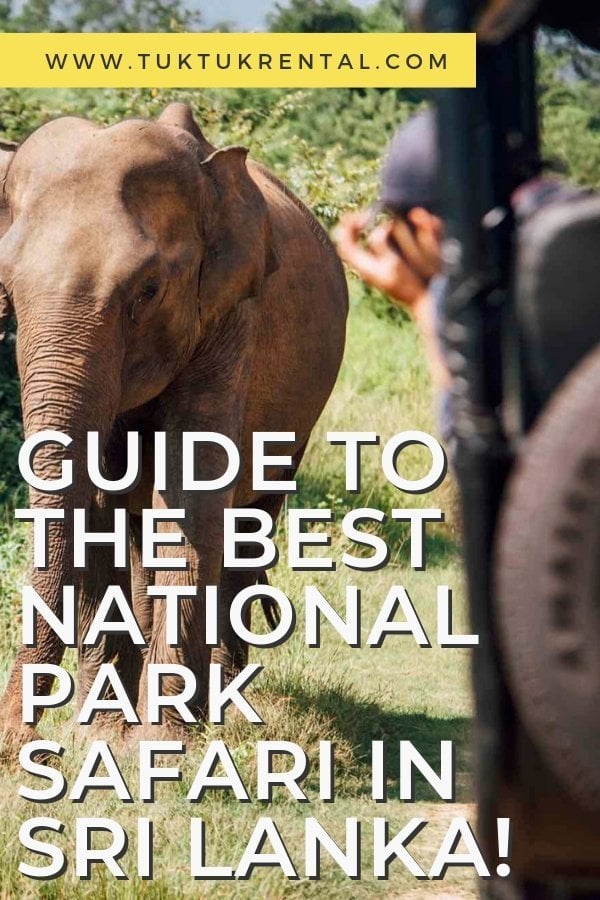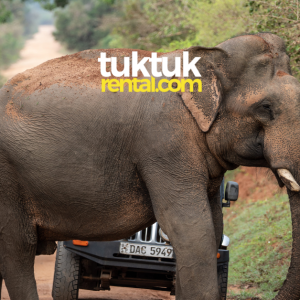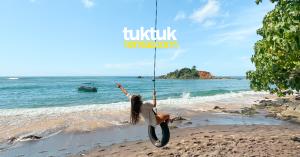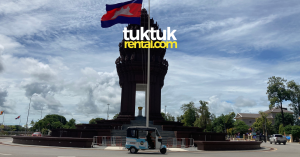Sri Lanka is a small island nation in the Indian Ocean, famous for its rich culture and beautiful beaches. In addition, the country is home to incredibly diverse plants and animals. Many of these species live in protected areas, including national parks and marine sanctuaries. These locations offer visitors a chance to experience Sri Lanka’s stunning natural beauty.
Welcome to the ultimate guide for the best national park safari in Sri Lanka! This is the most comprehensive online resource for wildlife information on the island.
Understanding Sri Lanka’s Protected Areas
National Parks
Sri Lanka’s national parks are protected areas that shelter a variety of plants and animals. The Department of Wildlife Conservation typically manages these parks. For instance, some of the most popular parks include Yala National Park, known for its large population of leopards and elephants. Another is Wilpattu National Park, which is famous for its leopards and sloth bears. Finally, Udawalawe National Park is celebrated for its large elephant herds and diverse bird species.
Marine Protected Areas
Marine Protected Areas are sections of the ocean that are protected to conserve the marine environment. The Department of Wildlife Conservation and the Coast Conservation Department usually manage these areas. For example, Pigeon Island National Park is known for its beautiful coral reefs and marine life. Similarly, Bar Reef Marine Sanctuary is also a popular spot for the same reasons.
Other Protected Areas
Sri Lanka also has other protected areas, such as forests and wetlands. These are crucial for conserving the natural environment. For example, the Sinharaja Forest Reserve is a UNESCO World Heritage site. It is home to a diverse array of plants and animals, including many rare and endangered species.
Safari Experiences
Safaris in Sri Lanka offer visitors a chance to explore these protected areas and see wildlife up close. Jeep safaris are a popular way to tour the national parks. On the other hand, boat safaris are a fantastic way to see the marine life in the country’s protected waters.
Overall, Sri Lanka’s protected areas provide a wide range of experiences, from exciting safaris to peaceful hiking and birdwatching. Whether you want to see rare species or simply enjoy nature, you will find something to love.
Your Ultimate Safari Guide
This guide is your ultimate source for information on Sri Lanka’s national parks, marine sanctuaries, and other protected areas. We offer valuable insider tips, including the best times to plan your safari and details on the country’s rich biodiversity.
Ecotourism and Safari Types
Ecotourism in Sri Lanka is a unique and fulfilling experience. However, the government regulates it to ensure safety and discipline. Within publicly accessible Protected Areas (PAs), you can officially enjoy several types of safaris:
-
Vehicular Safaris
-
Walking Safaris
-
Hiking Safaris
-
River/Reservoir (Boat) Safaris
-
Maritime (Boat) Safaris
-
Snorkeling Safaris
-
Diving Safaris
Outside of these main areas, ecotourism is less regulated but must still be conducted responsibly. This includes places like state forests, plantation forests, and environmentally sensitive areas. We’ve also highlighted amazing roads where you have a high chance of spotting elephants straight from your tuktuk—the real tuktuk safari of Sri Lanka!
National Parks in Sri Lanka
Yala National Park
Yala is the most visited and second-largest national park in Sri Lanka. It consists of six distinct blocks, each offering unique biodiversity and experiences.
Yala Block 1
Block 1 is by far the most famous and visited section of Yala, used exclusively for safaris.
-
Wildlife Highlights: Due to the habituation of its wildlife, Block 1 is a great choice for sighting the Terrestrial Big 5 (Elephant, Leopard, Sloth Bear, and Crocodiles). You will also consistently see herbivores like Sambar and Spotted Deer. Furthermore, the park boasts excellent birdlife.
-
Entrances: The Main Entrance (Palatupana) is 15 km east of Tissamaharama. Unfortunately, this entrance often has traffic jams of jeeps. Your experience will depend on your guide, as some follow the crowds while others seek quieter routes. A lesser-known Secondary Entrance is at Katagamuwa, which is much less busy.
-
A Note on Crowds: The government has set a daily limit of 600 jeeps, but this number is often exceeded during high season. This has a significant impact on the park’s wildlife. Sadly, there is no system to encourage jeep sharing, which results in many vehicles carrying only one or two people.
-
Best Time to Visit: Yala Block 1 is a year-round destination. However, the dry season from May to September offers a higher chance to see wildlife, as animals gather around waterholes. The park is closed to the public between October and December.
-
Insider Tip: Try to avoid weekends and public holidays. When visiting, please consider sharing a jeep with other travelers to reduce congestion.
Yala Block 2
Block 2 is one of the most remote areas of Yala, offering a unique and quieter nature experience.
-
Landscape and Wildlife: This block features a landscape closer to an African-style safari, with bushy terrain, large open plains, and lagoons. The wildlife here is shier due to fewer visitors. You will need a special permit from the Department of Wildlife Conservation (DWC) to enter.
-
Best Time to Visit: The ideal time to visit is from May to September. You should avoid the North-East monsoon period (late November to early January) at all costs.
-
Insider Tip: Visiting this remote area requires careful planning. You will need multiple modified jeeps stocked with food, water, medical supplies, and extra fuel.
Yala Block 3
Block 3 is the largest of Yala’s blocks and is heavily forested, similar to Wilpattu National Park.
-
Wildlife Highlights: Because of its dense forest, this block has an extremely high density of Leopards and Sloth Bears. Wild elephant sightings, however, are less common than in open environments. Typically, no more than one or two vehicles enter this block on an average day.
-
Best Time to Visit: You can visit throughout the year. However, it’s best to avoid the North-East monsoon from late November to early February.
-
Insider Tip: Since Block 3 is an old-growth forest, it is crucial to remain as quiet as possible during your visit.
Yala Block 4
This is the second largest block in Yala, with vegetation and wildlife sightings similar to Block 3. On an average week, only one or two vehicles will enter this area, offering a very exclusive experience.
-
Best Time to Visit: You can visit year-round, but avoid the North-East monsoon period from late November to early February.
-
Insider Tip: Like Block 3, this area is an old-growth forest. Therefore, maintaining silence is essential for a respectful and successful safari.
Yala Block 5
Block 5 is the smallest of Yala’s blocks, but it features a unique set of habitats and ecosystems that are the result of positive human interference, creating a very special environment.
-
Wildlife Highlights: You can spot Elephants, Leopards, Sloth Bears, various deer species, and many birds.
-
Best Time to Visit: This block can be visited throughout the year, but avoid the North-East monsoon.
-
Insider Tip: The Main Entrance to Block 5 also serves as the rear entrance for Lunugamvehera National Park. Consequently, you can visit both parks on the same entrance ticket.
Yala Block 6 (formerly Lunugamvehera National Park)
This area boasts a very high density of wild elephants and has vegetation similar to Block 1. However, it offers a different ecosystem, making for a wonderful safari experience.
-
Overview: This park is Sri Lanka’s 9th largest and is primarily made of grasslands, scrub forests, and artificial water bodies. It is home to elephants, sloth bears, leopards, and crocodiles.
-
Wildlife: The park is also home to 40 other mammal species, 32 reptile species, and 184 bird species.
-
Best Time to Visit: You can visit throughout the year, but it’s best to avoid the North-East monsoon.
-
Insider Tip: The rear entrance of this park is also the main entrance for Yala Block 5, allowing you to visit both on a single ticket.
Kumana National Park
Kumana is a key wilderness feature of the Eastern and Uva Provinces and is one of the best lesser-known national parks in Sri Lanka.
-
Wildlife Highlights: All five of Sri Lanka’s Terrestrial Big Five can be found here, including high densities of the rare True Wild Water Buffalo. The park is also home to a wide variety of mammals, reptiles, birds, and an incredible 52 species of butterfly.
-
Ecosystem: The park consists mainly of evergreen forests, riverine forests, and large coastal lagoons. A common misconception is that Kumana is only for birdwatchers, but its diverse wildlife proves otherwise.
-
Best Time to Visit: You can visit throughout the year, but avoid the North-East monsoon period.
-
Insider Tip: Avoid expecting guaranteed sightings of the big five. If you are interested in birds, make sure to visit the south-western part of Kumana in particular.
Udawalawe National Park
Udawalawe is one of the most famous national parks in Sri Lanka. Interestingly, about half of it is a modified ecosystem that humans reclaimed in the 1970s.
-
Landscape: Southern Udawalawe has open plains and grasslands, which is where most safaris take place. In contrast, northern Udawalawe still retains its original old-growth forests, though few visitors explore this area.
-
Wildlife Highlights: The park is home to elephants, sloth bears, leopards, and crocodiles. It also hosts an additional 40 mammal species and 184 bird species.
-
Best Time to Visit: You can enjoy a safari here throughout the year.
-
Insider Tip: Next to the park is the Udawalawe Elephant Transit Home (UETH). This is an ethical state-run elephant orphanage and medical facility, unlike some others on the island.
Wilpattu National Park
Wilpattu is Sri Lanka’s largest National Park and is fondly known as the “Land of Lakes” due to its many natural water bodies called Villus.
-
Overview: Wilpattu is a great place to spot the elusive Leopard outside of the busier Yala National Park. All five of the island’s Terrestrial Big Five live within its boundaries, including the mighty Saltwater Crocodile.
-
Ecosystem: The park is primarily made up of dry evergreen forests, riverine forests, and coastal mangrove forests. Its unique “Villus,” or natural sand-rimmed lakes, are scattered throughout the park.
-
Best Time to Visit: Wilpattu can be visited year-round, but try to avoid the North-East monsoon from late November to early February.
-
Insider Tip: This is your best option for realistic chances of seeing both Leopards and Sloth Bears in Sri Lanka outside of Yala Block 1.
Kaudulla National Park
Kaudulla is the epicenter of one of the planet’s greatest wildlife spectacles: the Great Elephant Gathering of Asia.
-
Wildlife Highlights: As expected, Sri Lankan Elephants are found in extremely high densities here, especially between June and September. The park also hosts leopards and crocodiles.
-
Ecosystem: The park consists mainly of seasonal grasslands and the Kaudulla Reservoir.
-
Best Time to Visit: The best time to visit is from early May to late September to witness the Gathering. Avoid the North-East monsoon.
-
Insider Tip: This is the best place to witness the global wildlife spectacle known as “The Great Elephant Gathering.”
Minneriya National Park
Like Kaudulla, Minneriya is another epicenter of the Great Elephant Gathering of Asia.
-
Wildlife Highlights: Elephants are found here in extremely high densities, particularly between June and September. You can also find leopards and crocodiles.
-
Ecosystem: Minneriya is primarily made up of seasonal grasslands and the vast Minneriya Reservoir.
-
Best Time to Visit: The ideal time to visit is from early May to late September for the Gathering.
-
Insider Tip: Along with Kaudulla, this is your best chance to see the incredible Great Elephant Gathering.
Wasgamuwa National Park
The name of this park comes from the Sinhala words for “Bear Village,” and for good reason.
-
Wildlife Highlights: The park has an extremely high density of Sri Lankan Sloth Bears. It also hosts elephants, leopards, and crocodiles.
-
Ecosystem: Wasgamuwa is mainly constituted of dry evergreen and riverine forests. It also features unique “Oxbow Lakes” that help prevent the Mahaweli River from flooding.
-
Best Time to Visit: Visit any time of year, but avoid the North-East monsoon from late November to early February.
(Content for Angammedilla, Bundala, Gal Oya Valley, Maduru Oya, Chundikkulam, Horton Plains, and Delft Island National Parks, as well as Other and Marine Protected Areas, has been structured for readability but retains the original detailed information.)
Tuktuk Safaris
Driving your tuktuk on certain roads offers a chance to see wildlife on your very own safari! However, you must be extremely cautious.
A Word of Warning
Wild animals are not pets and can be dangerous. This is especially true in an open vehicle like a tuktuk. Therefore, please read our elephant warning information before you begin.
Yala B35 Road
You will almost certainly see elephants on the B35 road that cuts through Yala National Park. Unfortunately, these elephants are often there waiting for food from passing vehicles. This has led to dangerous situations, as they may reach into your tuktuk to find food. Please be very careful.
Bundala to Yala Self-Drive
One of our customers had a fantastic self-drive tuktuk safari through Bundala Park and towards Yala. They saw crocodiles, water buffalo, about 20 varieties of birds, monkeys, monitor lizards, mongoose, a snake, and many peacocks. They noted it was amazing to be the only ones on the road, stopping whenever they wanted.
Tips for Your Safari Adventure
To get the most out of your safari experience, here are some helpful tips:
-
First, book your safari in advance, especially during peak season.
-
Next, choose the right time of day. Early morning and late afternoon are usually the best times for spotting wildlife.
-
Also, wear comfortable clothing and bring plenty of water and sunscreen.
-
Finally, bring binoculars and a camera with a good zoom lens to get a closer look at the animals.
Remember, you might not see every animal on the list. Most importantly, DO NOT FEED THE ANIMALS and NEVER LEAVE YOUR VEHICLE.




